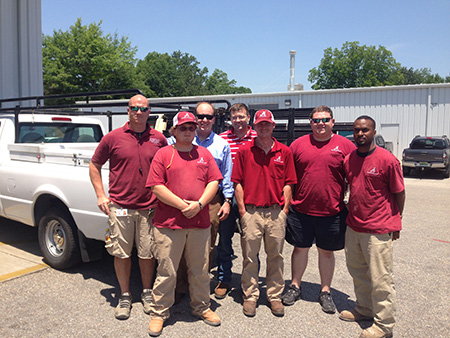« Return to FMDAA entries

University of Alabama
CATEGORY: Personnel
University of Alabama
Overview
In 2010, the management of Building Maintenance undertook an initiative to battle the stagnation of the careers of its laborers and trades helpers. Interviews were identifying a potential shortage of skilled candidates applying for the facilities management jobs. The two issues seemed to be related, and through strategic discussions, a training rotation was born. What started out as an informal training experiment resulted in the formal adoption of a program. Every six months a laborer is assigned to a trade. His assignment is to learn as much as possible during that time period. At the end of the period, the laborer is graded by his supervisors. The manager and associate manager then meet to review scores and offer mentoring for the future. Since its inception, the building maintenance laborer rotation program has contributed to the overall success of the department by increasing a core value of worker flexibility, creating a stocked pipeline of trained job applicants, and changing the perception of the laborer or helper position.
The University of Alabama feels so strongly that its employees be flexible when performing their jobs that it identified the characteristic as a core value. Flexibility is a trait utilized everyday by technicians serving the UA community. Scheduling maintenance and renovation work around an operating university is full of challenges. Planning and preparations are made, but the work is often interrupted by emergencies beyond anyone’s control. Flexibility comes into play when you can adapt and overcome these instances. Workers often get used to the daily routine that includes who they are working with. With comfort comes complacency. By rotating ambitious young workers, the journeymen themselves benefit because they are compelled to teach the skills they have obtained through years of experience. The commitment to a forced change every six months brings out flexibility in all. The result is a team that handles minor changes with major flexibility.
At UA Building Maintenance we are blessed to be able to attract high character people for all positions. Sometimes those candidates have all the intangibles but lack focused experience in one or more trades. The laborer rotation program provides that experience so that the workers are able to receive on-the-job training while “interviewing everyday” for upcoming positions. The grades they receive build a record that can be used to fit the right person to the right job. It also provides the laborer with a test run in many trades and creates an environment where a worker’s true skills and passions can be identified. Having a known product or pipeline of qualified workers increases the chance for promotions and decreases the risk of hiring the wrong person into a job.
Five years ago there was a laborer that had been working in a certain trade for 20 years. This laborer had developed very little in those years and was not relied upon at all to contribute to departmental success. Other persons were working in trades they had no interest in and were learning very little. They were, however, applying for jobs for which they did not meet minimum requirements. In fact, the laborer position had a stigma as a place where you could “make eight” or a place you could be parked until your real job opened up. New management saw this as a waste of resources and an irresponsible way to help its employees live up to their potential. The rotation program has reversed this negative connotation by allowing for some separation in the ranks of laborer.
Currently the department has nine people working in this program. Two have been promoted while others have put themselves in very good positions to do so. Journeymen are passing on valuable skills to worthy apprentices on a daily basis. Ultimately, the department has gained a force of workers that are flexible and ready to contribute in many areas, are attractive job candidates, and are considered valuable to overall productivity of the organization. The future looks bright in UA Building Maintenance!
In-house Participants
Brad Kelley, Laborer
Tyler Morrison, Laborer
Anthony Colquitt, Laborer
Ben Hamner, Tradeshelper
Bobby Harrell, Laborer
Kobi Parsons, Tradeshelper
Adrian Mills, Laborer
Michael Deason, Laborer
Duane Lamb, Assistant Vice President Facilities and Grounds
Paul Wuebold, Executive Director Facilities and Grounds
Todd Copeland, Facilities and Grounds Human Resources Partner
Clint Hamner, Associate Manager Building Maintenance
Neal DiChiara, Manager Building Maintenance
Additional Information
UA Building Maintenance and Pest Control: A Review (Powerpoint)

↑ Back to top








